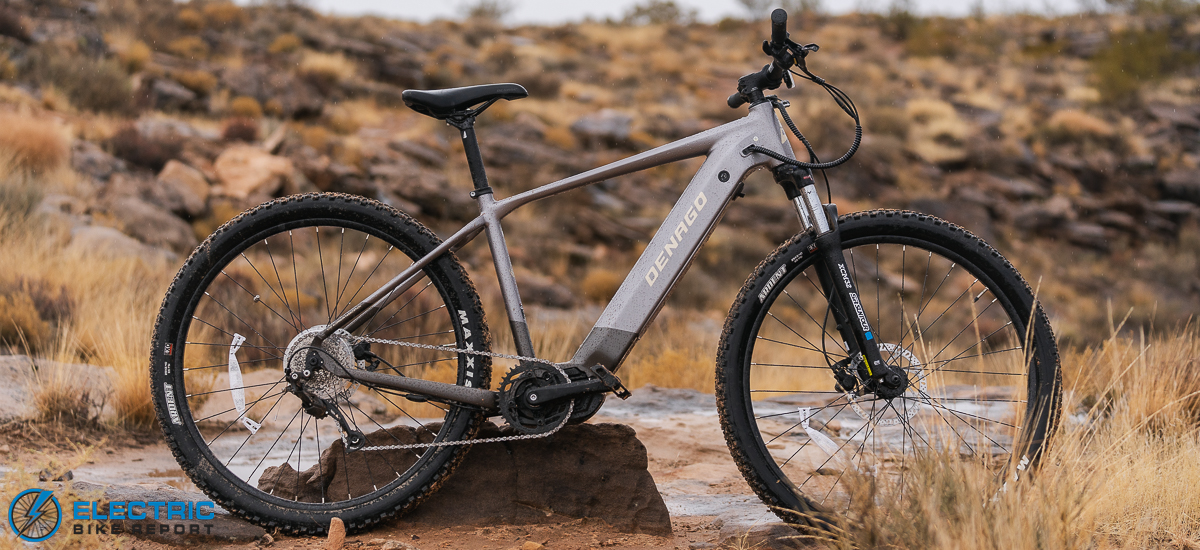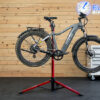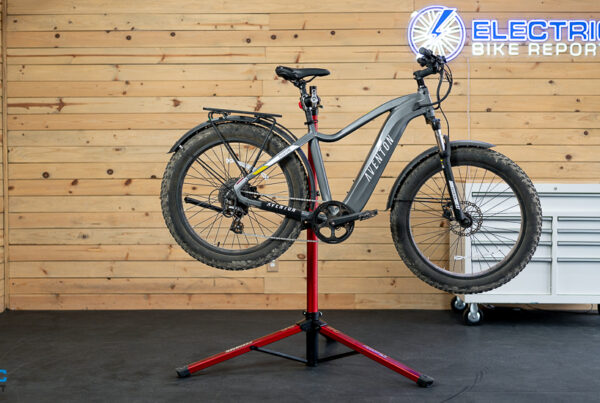Overall, we found the ride quality of the eXC1 to be solid; the bike has modern geometry for good stability and handling. We see this as one of the largest pros; despite being an entry-level eMTB that includes lower-tier components, it’s a great starting point for those who may want to gauge their interest before investing in upgrades or who might live in an area with smoother, less demanding trails.
We appreciated seeing that Denago offers the eXC1 in three frame sizes to accommodate riders from 5’-5” up to 6’-5”; many e-bikes on the affordable end of the spectrum are often limited to a single-size frame.
The Medium frame (for riders between 5’-5” and 5’-9”) includes 740mm handlebars, while the Large (5’-10” to 6’-1”) and XL (6’-1” to 6’-5”) are equipped with 780mm bars. Our test bike was a Large and fit our testers in that height range well, and we appreciated the stability and precise steering granted by the wider bars.
While the head tube angle is the same (67.5 degrees) across all three frame sizes, the seat tube angle ranges from 74.1 degrees on the Medium to 73 degrees on the XL. The reach ranges from 444 mm on the Medium to 484 mm on the XL.
We liked that the bike included 29” wheels with 2.4” wide Maxxis Ardent tires; these provided great traction on hardpack but also did well on loose terrain. The large wheel size helped the bike to feel much more comfortable when rolling over rocks, though the Suntour XCM 32 suspension fork softened the ride as well.
As a spring fork with 100mm of travel, it was basic but functional; we had no complaints when riding on beginner- and intermediate-level trails. The eXC2 features a better, but still entry-level XCM 34 Boost fork for riders seeking a more comfortable ride. Regardless of model, those spending more time on technical trails or those with rock gardens or lots of roots may want to upgrade to a higher-quality air fork.
A similarly-basic component was the mixed Shimano Altus/Alivio drivetrain. We found that it worked well enough, but we did encounter significant chatter when riding over chunky terrain. This is another component that eXC1 owners may want to consider upgrading when maintenance/replacement parts are needed; we recommend the Shimano Deore or SLX groupsets.
We found the motor to be suitably responsive, providing power when it was needed without much lag, though there is a built-in delay that occurs when shifting. This “shift sensing technology” is designed to protect the drivetrain from excess wear from shifting under load. While we think beginners may find it helpful, we’d prefer the ability to turn it off; it was easy to lose momentum in some situations on unfamiliar sections of trail.
The eXC1 does not include a display screen; instead it uses a series of LED indicators on the control panel to communicate battery charge level and PAS setting. We liked the clean, minimal cockpit that resulted from this choice, but we did find the blue PAS indicators to be difficult to see without leaning. Overall, the system worked well by feel, but we’d challenge Denago to find a more visible solution on the next iteration of the bike.
Minor gripes aside – and they are minor – we found ourselves highly impressed with the overall feel and capability of the eXC1. For its price, we think it would be tough to find a better-performing bike out there!
.
.
.
#Denago #eXC1 #EBike #Review #Electric #Bike #Report
Source link








